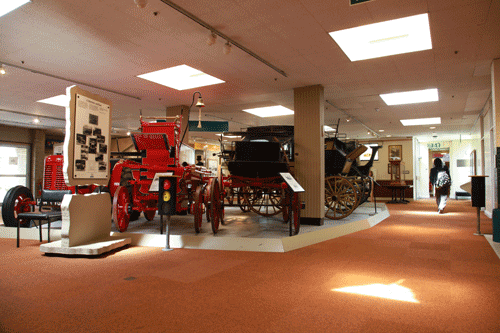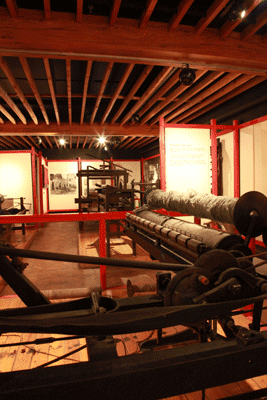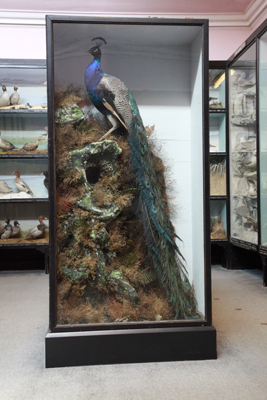Permanent galleries
Take a journey through the Going Places transport gallery, a collection of historic carriages, cars and bicycles that have kept Huddersfield moving through history.

The exhibition includes:
- Britain's rarest car - the three-wheeled LSD - which was manufactured locally between 1919 and 1924.
- An early 19th Century Pack Saddle used for carrying a 'piece' of cloth to market.
- A 19th Century horse-drawn Hansom Cab, Wagonette and Station Omnibus all made in Huddersfield.
- A fascinating range of cycles from the Velocipede of 1868-72 and the wonderful Singer Sociable tricycle ridden in Lockwood, Huddersfield in the 1880s, on which two people could ride together sitting side by side; through to early 20th Century bicycles.
The local textile industry created wealth for mill owners such as the Beaumont's who lived in Ravensknowle Hall before it became Tolson Museum.
Displays of machinery and artefacts, from processes including spinning, weaving and cropping, explanations of how the factory system changed the lives of workers and of the spirited resistance to new machinery by the Luddites.

You can see:
- A hand cropping bench and shears and a display of the frames, so detested by the Luddites, which mechanised the process of cropping.
- Other Luddite related artefacts including Enoch's Hammer and a hair tidy made by one of the Luddites whilst awaiting trial at York Assizes.
- A Jacquard Loom used in Huddersfield for the 'fancy' trade of making elaborately patterned shawls and waistcoatings.
- Exquisite local samples of fine 19th Century hand-loom woven fancy fabrics.
The Ramsdens were the founders of the Huddersfield we know today. In 1599 William Ramsden bought the Manor of Huddersfield as a small Pennine village; it developed into a major town and 'one of the principal seats of the woollen trade in the Kingdom'. The estate was sold to Huddersfield Corporation in 1920 for £1,300,000.
Amazing objects to see are:
- The Skelmanthorpe Flat, part of Tolson's top ten treasures
- Richard Oastler memorabilia including Flag carried at an 1832 demo in York - the 'Factory King' campaigned for factory reform for children:
- A fine Suffragist banner - 'Votes for Women Huddersfield and district'
- A rare road Toll Board c.1923-4
- Painting view of Huddersfield by William Cowen, 1849
"The Town that bought itself". In 1800 Huddersfield was still only an oversized village. Most people worked in the domestic weaving trade or farmed small patches of land. Before the end of the century Huddersfield was a town of growth, prosperity and culture, boasting many fine buildings.
Things to see are:
- Textiles - pattern books, Great Exhibition 1851, carved cloth printing blocks, wage cups for mill workers
- Culture - locally made violins and clarinets, the unusual Ophicleide and 'serpent', Mrs Sunderland's desk
- Law and order - 19th Century police truncheons, housebreaker's skeleton keys, knuckle dusters, watchmen's rattles
- Civic memorabilia - Huddersfield's first mace, mayoral robes, commemorative items.
The stunning Tolson Bird Room was opened in 1925 and is a splendid and rare example of historical collecting and display. Most of the birds are from even earlier; the collection was purchased as the nucleus of a museum for Huddersfield.

The evocative display cases were all handmade by Seth L Mosley, the museum's first curator. He displayed each species in its own particular environment, whether moorland or meadow; woodland or water.
There are Pheasants and Finches; Crows and Owls; Geese and Ducks and scores of small birds such as Golden Oriole, Yellowhammer and Pied Flycatcher.
A gallery commemorating the centenary of the First World War focusing on objects, photographs and stories from the period.
You can discover:
- The story of the museum, which is one of Kirklees' most significant War Memorials. Legh Tolson gave his home to the people of Huddersfield in 1919 to become a museum in memory of his two young nephews who died in the First World War.
- A rare Corporal's tunic, worn by a soldier of the 2nd Battalion of the Duke of Wellington's regiment.
- Rare charity armbands, worn by fundraisers, from various events in the Huddersfield area between 1915 - 1916.
- Loss and Legacy: The Tolson Story - The film below tells the poignant story of the Tolson brothers and the profound effect the First World War had on the family. Their story echoes the impact of war on many people's lives in and around Huddersfield at the time. The film is based on letters between the Tolson brothers and their family back home. Special thanks to the Tolson Family, the Heritage Lottery Fund, and Glass Cannon.
Launched to mark the centenary of the 1918 Act which gave women over 30 the right to vote, 'Our Fight for the Voting Right' celebrates and explores the outstanding stories of the suffragettes and suffragists of Kirklees.
Pride of place goes to the iconic 'Votes for Women' banner, designed and created by Florence Lockwood of Linthwaite, Huddersfield. The stunning banner, recently conserved, will be displayed alongside Florence's artwork, local photographs, political badges, papers and original Edwardian costume. Also featured is Dora Thewlis who, as a local 16 year old mill girl, was arrested and imprisoned for marching on Westminster with the Women's Social and Political Union (WSPU). She was dubbed the 'Baby Suffragette' by the press.
Discover fascinating stories of local campaigners from both groups and earlier suffrage organisations from the area. Find out the difficulties Victorian and Edwardian women faced as they dared to challenge their traditional roles in society.
'Our Fight for the Voting Right!' is supported by Arts Council England's Museum Resilience funded Sustainable Collections project.
Was this information useful?
We'd like your feedback to improve the Kirklees Council website and the information we provide.




